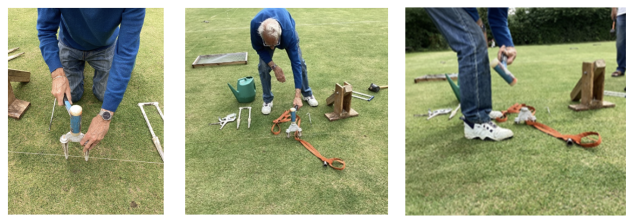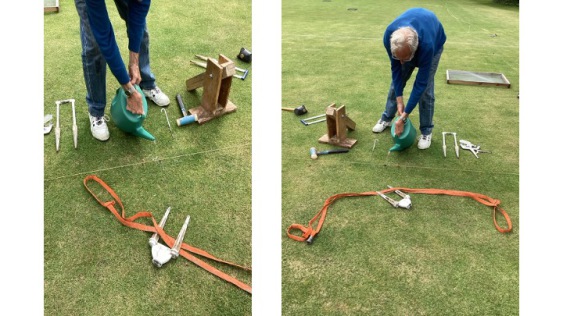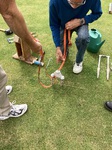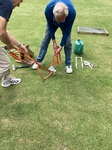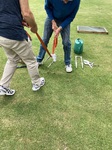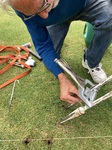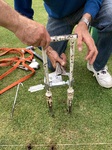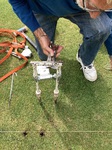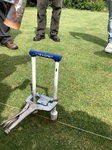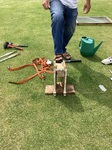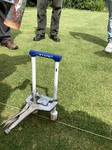Hoop Setting
Hoop setting is the most time-consuming job, especially so when the ground is hard. It requires great precision, so should not be rushed.
Stringing out is the first aspect and its purpose is that hoops may be set accurately and squarely. Care should be taken to check throughout the process that hoops are being set squarely to the strings and at 90 degrees to the ground.
This is best done my deploying observers to advise whoever is hammering home either the hole maker or the actual hoops that they are being hammered home true. Upright and square.
A metal headed mallet should not be deployed on the hoop-hole maker as it will destroy the equipment as our unfortunate past experiences have confirmed. Always first lay down a device to lift the hoop hole maker before hammering home (we currently use an old section of orange hose because it is strong and relatively easy to grip).
If the ground is hard making the holes is best done in partial stages with the aid of standing water in the partial holes to soften the ground. This effectively means working on more than one set of hoop holes progressively as the hole itself is softened by the watering. Muddy splatter is an unfortunate consequence to be avoided with the help of common sense.
To correctly calibrate each hoop we have a silver coloured metal calibration tool which should be affixed near the base of each hoop and calibrated by means of the measure. The metal tool is effectively a double clamp which holds the hoop being set in a fixed position to the correct gauge having been set by the plastic measure. This should be applied to each appropriate hoop for each lawn as defined by the particular hoop hole and hoop number.
The specific measures shown on our gauge is 3 ¾ inch or 3 11/16 inch. We should be using the 3 ¾” measure on the gauge.
Use of the calibration tool and a video sample of hoop setting may be seen here: https://www.croquet.org.uk/?p=tournament/equipment
White mallets must always be used when hammering match hoops. Other rubber mallets may only be used on very old battered and retiredhoops. Care should be taken that both holes and hoops should not be hammered home to a depth level with or below the surface. The ideal depth of the carrot tops above the surface (about ¼ to 1/3 inch) can be gauged with the aid of a croquet ball which should not make contact with the top of the carrots.
Always but always use the hoop remover to remove any hoop and be sure to use and calibrate all the appropriate numbered match use hoops for all 18 sets of hoop holes.
It also helps as an aid to check visual alignment if lawn 3 hoops are left in when setting lawn 2 (or vice versa).
Never use a twisted hoop, the one we still hold in the hut should be avoided.


